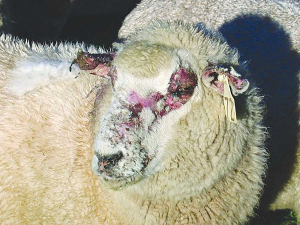Perfect conditions for fly and FE
Warm wet weather in many areas of the country creates the perfect conditions for the production-limiting diseases flystrike and facial eczema (FE).
 FE causes damage to the bile system of the liver of the animal which can reduce a ewe’s lifetime productivity by 25%. A secondary effect is photosensitisation, which causes skin reddening and peeling, leaving affected area susceptible to other infections.
FE causes damage to the bile system of the liver of the animal which can reduce a ewe’s lifetime productivity by 25%. A secondary effect is photosensitisation, which causes skin reddening and peeling, leaving affected area susceptible to other infections.
A pilot study investigating the potential of a facial eczema (FE) tolerance test is being launched this month.
The purpose of this pilot study, which is being led by AgResearch’s Dr Axel Heiser and funded by Beef + Lamb New Zealand (B+LNZ), is to test the feasibility of a laboratory-based test to determine an animal’s tolerance to the toxin associated with FE.
If initial results look promising, the test will require further development and full validation to make it a readily available test for breeders and commercial farmers.
FE has been around in New Zealand for over 100 years.
The cause of the disease is attributed to the toxin sporidesmin, produced by the fungus Pithomyces chartarum. This spore-producing fungus sits in the litter at the base of pasture swards.
Sporidesmin causes damage to the bile system of the liver of the animal which can reduce a ewe’s lifetime productivity by 25%. A secondary effect of the liver damage is photosensitisation, which causes skin reddening and peeling, leaving affected area susceptible to other infections. It is suspected that for every clinical case of FE there are 10 more with the disease.
This disease causes significant production losses and impacts on the welfare of affected animals. It has been estimated that in a bad year, FE can cost the country $266 million in lost production.
More common in warm, moist environments, a changing climate means FE is likely to spread further into southern regions over time.
Most research into FE is historical and limited management tools are available. This is despite the significance of FE and the length of time it has been affecting livestock in NZ.
“This (latest) work is a great example of B+LNZ investing in research now to find solutions to a problem that farmers face now and that will become worse over time” says Dan Brier, B+LNZ’s general manager farming excellence.
The pilot study gets underway this month and results are expected by March 2021. If the pilot is successful – and funding can be secured – validation and implementation of the test is expected to be completed by late 2022.
Heiser says that with new science approaches and technologies, there is an opportunity to find a solution to this serious issue for New Zealand farmers.
Alongside this proof-of-concept work, B+LNZ will be working with Heiser to build a collaborative funding bid to for a larger research programme to investigate the knowledge gaps of FE in New Zealand.
This programme aims to provide several new strategies to reduce the occurrence and impact of FE for farmers.
• For more information about Facial Eczema go to: https://beeflambnz.com/knowledge-hub/PDF/facing-facial-eczema
A New Zealand-first native tree study has highlighted the Bioeconomy Science Institute's position as a forestry research leader.
Hemp fibre processor Rubisco is relocating its core processing facility to Ashburton as part of a $20-$30 million expansion to leverage what it says is an accelerating global demand for sustainable and renewable fibres.
Tradition meets some of the latest in technology at the 2026 East Coast Farming Expo.
OPINION: Trade Minister Todd McClay and the trade negotiator in government have presented Kiwis with an amazing gift for 2026 - a long awaited and critical free trade deal with India.
Former Agriculture Minister Nathan Guy says he's excited about his new role as NZ's Special Agricultural Trade Envoy.
A pillar of New Zealand's horticultural industry, Dr Stuart Davis, was farewelled at a well-attended funeral service in Tuakau, South Auckland, on December 18.

OPINION: If the hand-wringing, cravat and bow-tie wearing commentariat of a left-leaning persuasion had any influence on global markets, we'd…
OPINION: With Winston Peters playing politics with the PM's Indian FTA, all eyes will be on Labour who have the…